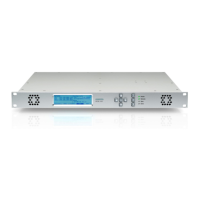RCS User Manual
27
All the parameters are explained bellow.
Inputs:
- Alias: is a name that the user can assign to the input and that will appear in the top bar of the
web application, allowing the user to identify the input easily.
- Enable: allows to enable/disable the input.
- Admin Lock: all the inputs may be locked by the administrator (Admin Lock). See section
1.3.- System users.
If an input is locked, the users that are not administrator can not change the tab to access
another feature. They can only see that input in the operating mode that the administrator
selected.
- Impedance (only for RF inputs): allows to select the input impedance.
- T2-MI mode (only for RF inputs): if the RCS has the 902513 option,the user can enable the
T2-MI mode in any input.
- T2-MI PID (only for RF inputs): if the T2-MI mode is enabled, the user must indicate the PID
packet which conveys T2-MI packets. This PID usually is 0x1000, but it can be different.
- T2-MI Est. Tx Time (only for RF inputs): is the maximum expected transmission time. This
parameter is used to calculate the network delay measurement.
- Auto Enabled Polling Mode (only for RF inputs): if you select ON, the RCS is forced to go
back to polling mode automatically 10 minutes after the polling mode was deactivated by an
user.
- Enable Alarms Report: if you select ON, you indicate to the RCS that you want to receive an
alarm report of this input in your e-mail account. See section 1.1.1.- System.
Outputs:
There are 3 output types: ASI, IP (option 902518 for RCS100 and RCS400) and Stream to local. All
of them have the enable/disable switch.
- ASI outputs: the Source parameter allows to select the input signal the user wants to have at
the ASI output.
- Stream to Local output: allows to send the stream using the control Ethernet connector. The
stream can be sent to the IP of the computer that is controlling the RCS (Stream to local
mode Auto) or to any other IP (Strem to local Manual), in this case the user must enter the
IP address and the port. In addition there is a button that allows to stop the transmission.
- IP outputs: allows to send the stream using any Ethernet connector, except the control one
(use the Network interface switch). The stream can be sent to any IP. The user must enter
the IP address and the port. In addition there is a button that allows to stop the transmission.
Synchronization:
If your RCS doesn’t have the internal GPS option, there is only one way to synchronize the
RCS, and is by using 1PPS signal.
- In this case, the 1PPS signal must be connected to the RCS

